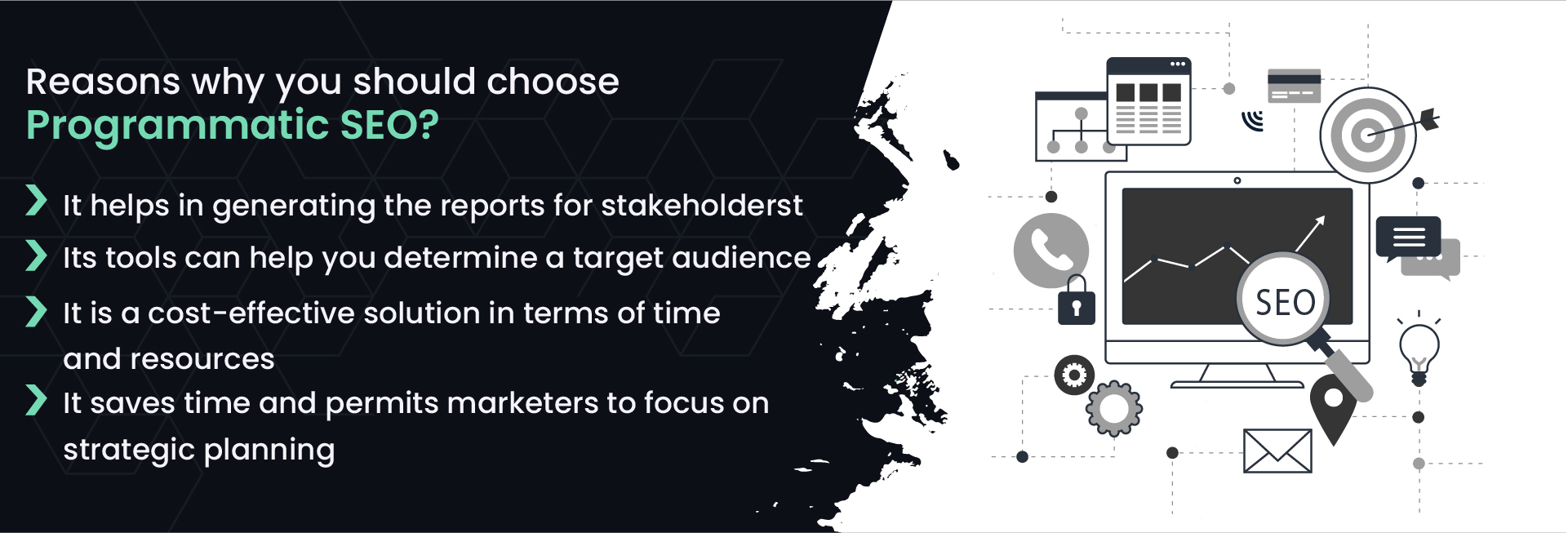
Programmatic SEO Helps In Boosting Your Website Speed
Whenever you start a business, you want your website to rank first and reach more traffic. Do you also want it? If yes, then you need programmatic SEO which will help you to reach more traffic. Also, it is a cost-effective and time-saving process. However, website speed is not only about the user convenience and experience but it is all about the ranking on the search engines. The more you boost your website speed, the more your website ranks on the search engines.
Additionally, it is not only about the website meeting requirements, but also makes sure that the speed of your website expectations must reach the modern online audience. As we delve into a deeper understanding of Programmatic search engine optimization, we will reveal the complicated relationship between website speed and SEO success. So, let’s join us in this comprehensive guide in which we reveal the implementation of Programmatic SEO, which will boost your website speed and user experience and enhance your online visibility to reach more traffic.
Definition and Basics of Programmatic SEO
Programmatic SEO uses automated and data-driven methods to boost and optimize your website’s online visibility. Unlike traditional SEO, which mostly depends on human edits or random updates, it uses real-time data and automation technologies to improve the website’s position on search engines. Hence, by using existing data and pre-programmed rules, it is the method through which you can create a bunch of optimized web pages at once.
In short, the aim or objective of Programmatic Search engine optimization is to increase the website’s online visibility and reach more traffic and potential customers. Also, by analyzing the real-time data continuously, it quickly shifts to user behavior, search engine algorithms and industry trends. On the contrary, it makes sure that the website remains at the front of the search engine results and reacts quickly and rapidly to user interactions and search engine algorithms.
The Impact of Website Speed on SEO
In this fast-paced world, where user experience plays an essential role in online visibility, website speed becomes visible as a pivotal factor that influences the website’s search engine optimization performance. Search engines like Google, Microsoft Bing or Yahoo consider numerous features to rank websites, and also the speed at which website loads has become increasingly notable. This article delves into a deeper understanding of the impact of website speed on SEO and why it is important for online success.
User Experience and Bounce Rates
User experience is directly affected by website speed, and search engines prioritize the results that increase user experience. If your website slows down, it decreases the leads because the visitors get frustrated when the page takes too much time to load. This increases the bounce rates and conveys negative signals that result in lower rankings. In contrast to this, if the website loads fast, then it increases the leads and engages more users, which will contribute to a positive user experience. Hence, it sends positive signals to the search engines that the content is relevant and valuable.
Search Engine Ranking Factors
A website’s content quality and relevance can be determined through various factors of search engines. The important ranking factor is website performance, as Google’s Page Experience emphasized Core Web Vital metrics. To measure the user-centric performance, these metrics are involved: Largest Contentful Paint (LCP), First Input Delay (FID), and Cumulative Layout Shift (CLS).
Technical Aspects of Website Speed
To determine the website’s speed and visibility, technical components play an essential role in it. Server response time, image optimization and efficient coding all engage in the response of how a website loads quickly. All these technical aspects are important to enhancing the website speed and also improving SEO performance.
How Programmatic SEO Boosts Website Speed
To optimize your website speed, how do you implement Programmatic SEO? Let’s delve into it;
Real-time content updates
Because of its real-time nature, it transforms quickly to innovation in user preferences and content demand. To make immediate adaptations, Automated algorithms inspect user behavior, trending keywords and other relevant data. This makes sure that your content is relevant and engaging with what your audience is searching for.
Dynamic Keyword Optimization in Programmatic SEO
The backbone of SEO is keyword optimization, and Programmatic search engine optimization takes this keyword optimization to the next level. The automated system makes sure that the keywords must be improved to match what users are searching for. This approach makes sure that your website stays connected with the latest search trends, helping it get indexed by search engines faster and more accurately.
Efficient Meta Tag Management
Meta tags play an important role in recognizing your content on search engines by providing some information about it. Through automation, Programmatic Search engine optimization manages up-to-date meta tags based on real-time data. Also, make sure that search engines can quickly crawl and index your pages, leading to enhanced website speed in the indexing process.
Image Compression And Optimization Through Programmatic SEO
If you used large and uncompressed images then it could slow down the website. Programmatic search engine optimization handles this issue efficiently and by image compression and optimization processes.
Step By Step Guide For Implementing Programmatic Seo
Implementing Programmatic search engine optimization can be a complicated task, but breaking it into a few steps can make it easier. Below, step-by-step guides are mentioned for you that will help in the implementation of Programmatic SEO;
Recognize Your Audience
First, you should research well about your target audience’s choices, their habits and their findings on search engines. Also, which type of content does your audience find valuable? All this knowledge will help you build an effective Programmatic SEO.
Audit Your Current SEO Strategy
Now, you should research your current strategy of SEO, determine what’s working well. Also, identify areas which need improvement. This evaluation will help you to assess how it can enhance your current efforts.
Pick Your Long-Tail Keywords for Programmatic SEO
Focus when picking the keywords, it should be long-tail keywords with low KDA and high volume. When the keyword is used in an effective way, it means the audience is finding it more, and then the more chances of ranking your website.
Set Realistic Goals for Programmatic SEO
Set your clear and realistic goals for Programmatic search engine optimization implementation. Whether it’s enhancing your website speed, user engagement, online visibility or increasing organic traffic, having specific goals will guide your strategy.

Challenges of Programmatic SEO
Here, a few things are mentioned that you need to keep in mind when choosing it;
- First, remember that Programmatic search engine optimization is not suitable for every business. Website content must be relevant and engaging, and if your business doesn’t lend this kind of content itself, then it will be a wasted effort.
- Second, you must focus on the quality of your content. The content must be engaging, so create high-quality content that can engage more readers.
- Last, you must be informed about the industry trends to compete with marketers when doing Programmatic SEO.
Benefits of Programmatic SEO
Programmatic SEO Helps in Improving Quality
It helps you to improve the quality of your results. Because it allows you to make your efforts quickly and efficiently, it can also help results in less time than traditional SEO.
Programmatic SEO Enhanced Your Website Speed
One of the primary benefits of Programmatic SEO is that it enhances the website speed. Keyword optimization, content updates and meta tag optimization result in loading faster times that improve user experience and positively influence search engine rankings.
Programmatic SEO Helps in Improving User Experience
It improved the user experience by aligning the keywords, content and other elements with user preferences. It also helps in reducing the bounce rates.
Reach More Traffic Through Programmatic SEO
By increasing online visibility on search engines, it helps in reaching more traffic than before.
How to Create Programmatic SEO Pages
Keyword Research and Content Planning
The foundation of Programmatic SEO is identifying the keywords. You will require the search to find the head term and modifiers so that you can measure whether there is enough search volume for keywords that are relevant and profitable.
Design Your Page Template for Creating Programmatic SEO Page
When you are doing Programmatic SEO, make sure that you design your page template in a way that is relevant to your content. The goal must be user intent and make sure your page is helpful, complete and accurate.
Understand Your Target Audience
When it comes to dealing with Programmatic SEO, make sure you properly understand and know about your target audience. Also, you should know about their search habits and choice of content. It will help you to resonate your content with the audience and it will engage more customers that will convert into leads.
Identify And Collect Your Data to Create Programmatic SEO Page
Make sure that you collect data from reputable sources. It must be well-defined and have high qualitative content, and it is only done when you have researched it well.
Also, there are various methods of collecting data. It includes scraping websites, hand collecting private or hard to access data or manual entry or curating user-generated content.
Test the sight and make adjustments if required.
Once you have done everything properly, make sure that your website is running properly on every device or not. So, if any issue is detected, you can easily resolve it before it decreases your website ranking.
Regular SEO vs Programmatic SEO
Regular SEO conducts a longer and more manual process for content creation. It helps in increasing online visibility by using specific keywords in landing pages and blog posts more effectively. Also, users can find the content through organic search engines when you have done Regular SEO.
On the other hand, Programmatic search engine optimization is the opposite. It is a shorter and more automated process for content creation. It only helps in landing pages centered around specific keywords. Also, through this SEO, users find the landing pages through the organic search engines.
Conclusion
In conclusion, Programmatic search engine optimization is a strategic method that improves automation, data analytics and personalization to increase online visibility and performance. Hence, it not only improves efficiency by automating tasks, analyzing data for insights, and tailoring content to individual preferences, but it also helps enable competitors to make decisions for continuous optimization. In short, it is a powerful tool that can enhance your online visibility and reach more organic traffic on landing pages. Also, it helps in reaching your target audience through proper automatic and real time data analysis.
Questions? Look Here.
Because, it helps in creating thousands of pages targeted at thousands of keywords without doing things manually like publish, write and design it.
Traditional SEO involves manual optimization efforts, while Programmatic SEO does automation and data analysis in real-time.
Programmatic SEO works by finding thousands of keywords with one basic page template, so to learn it. You first need to find various relevant keywords that have hundreds or thousands of similar variations.


